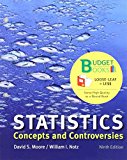
Concept explainers
(a)
To find: The 95% confidence interval for the proportion of adults who feel that basic medical care in the United States was affordable when the
(a)
Answer to Problem 16E
Solution: The confidence interval is
Explanation of Solution
Calculation:
For a two-tailed test at 5% significance level, the tabulated value of
Compute the confidence interval using the formula as follows:
where
Now, compute the 95% confidence interval as follows:
Interpretation: It can be concluded with 95% confidence that proportion of adults who feel that basic medical care in the United States was affordable lies between approximately 48.4% and 55.6%.
(b)
To find: The 95% confidence interval for the proportion of adults who feel that basic medical care in the United States was affordable when the sample size n is 1500.
(b)
Answer to Problem 16E
Solution: The confidence interval is
Explanation of Solution
Calculation:
For a two-tailed test at 5% significance level, the tabulated value of
Compute the confidence interval using the formula as follows:
where
Now, compute the 95% confidence interval as follows:
Interpretation: It can be concluded with 95% confidence that proportion of adults who feel that basic medical care in the United States was affordable lies between approximately 49.5% and 54.5%.
(c)
To find: The 95% confidence interval for the proportion of adults who feel that basic medical care in the United States was affordable when the sample size n is 3000.
(c)
Answer to Problem 16E
Solution: The confidence interval is
Explanation of Solution
Calculation:
For a two-tailed test at 5% significance level, the tabulated value of
Compute the confidence interval using the formula as follows:
where
Now, compute the 95% confidence interval as follows:
Interpretation: It can be concluded with 95% confidence that proportion of adults who feel that basic medical care in the United States was affordable lies between approximately 50.2% and 53.8%.
(d)
To explain: The difference in results obtained in part (a), part (b), and part (c).
(d)
Answer to Problem 16E
Solution: The width of confidence interval reduces as the sample size increases.
Explanation of Solution
The confidence interval obtained in part (b) with sample size 1500 is approximately 49.5% to 54.5%.
The confidence interval obtained in part (c) with sample size 3000 is approximately 50.2% to 53.84%.
So, from the confidence intervals obtained in parts (a), (b), and (c), it can be concluded that as the size of sample increases, the width of confidence interval reduces.
From the results of part (a), part (b), and part (c), it can be concluded that with the increase in sample size, the width of confidence interval reduces.
Want to see more full solutions like this?
Chapter 21 Solutions
Loose-leaf Version for Statistics: Concepts and Controversies 9E & LaunchPad
 MATLAB: An Introduction with ApplicationsStatisticsISBN:9781119256830Author:Amos GilatPublisher:John Wiley & Sons Inc
MATLAB: An Introduction with ApplicationsStatisticsISBN:9781119256830Author:Amos GilatPublisher:John Wiley & Sons Inc Probability and Statistics for Engineering and th...StatisticsISBN:9781305251809Author:Jay L. DevorePublisher:Cengage Learning
Probability and Statistics for Engineering and th...StatisticsISBN:9781305251809Author:Jay L. DevorePublisher:Cengage Learning Statistics for The Behavioral Sciences (MindTap C...StatisticsISBN:9781305504912Author:Frederick J Gravetter, Larry B. WallnauPublisher:Cengage Learning
Statistics for The Behavioral Sciences (MindTap C...StatisticsISBN:9781305504912Author:Frederick J Gravetter, Larry B. WallnauPublisher:Cengage Learning Elementary Statistics: Picturing the World (7th E...StatisticsISBN:9780134683416Author:Ron Larson, Betsy FarberPublisher:PEARSON
Elementary Statistics: Picturing the World (7th E...StatisticsISBN:9780134683416Author:Ron Larson, Betsy FarberPublisher:PEARSON The Basic Practice of StatisticsStatisticsISBN:9781319042578Author:David S. Moore, William I. Notz, Michael A. FlignerPublisher:W. H. Freeman
The Basic Practice of StatisticsStatisticsISBN:9781319042578Author:David S. Moore, William I. Notz, Michael A. FlignerPublisher:W. H. Freeman Introduction to the Practice of StatisticsStatisticsISBN:9781319013387Author:David S. Moore, George P. McCabe, Bruce A. CraigPublisher:W. H. Freeman
Introduction to the Practice of StatisticsStatisticsISBN:9781319013387Author:David S. Moore, George P. McCabe, Bruce A. CraigPublisher:W. H. Freeman





